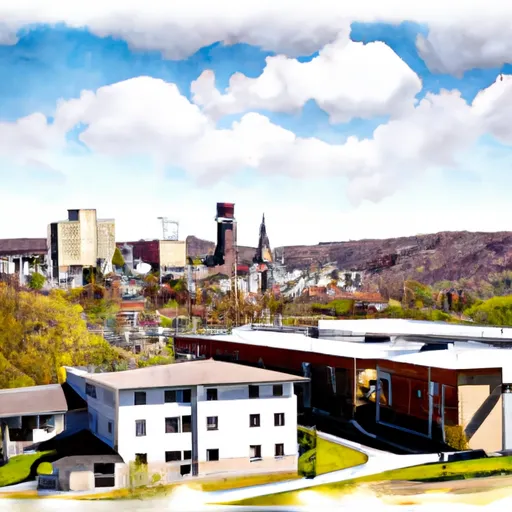-
 Snoflo Premium
Snoflo Premium
Get unlimited access to all our content
With no Ad interruptions! - Start Your Free Trial Login with existing account
Warriors-Mark
Eden Index
Climate
7.7
•
Recreation
3.1
•
Community
•
Safeguard
4.2/10

Warriors Mark, Pennsylvania is a charming rural community situated in Huntingdon County. The region experiences a humid continental climate, characterized by warm summers and cold winters. Average temperatures range from the low 20s°F (-6°C) in winter to the high 70s°F (25°C) in summer, offering a diverse range of outdoor activities throughout the year.
The hydrology constituents of Warriors Mark are predominantly shaped by the Bald Eagle Creek and the Little Juniata River. These waterways not only contribute to the region's scenic beauty but also provide opportunities for fishing, boating, and kayaking. Anglers can enjoy a variety of species such as trout, bass, and catfish.
Outdoor recreation enthusiasts can explore the picturesque landscapes of Warriors Mark by hiking or biking along the nearby Appalachian Trail or the Warriors Path State Park. The park also offers camping facilities, picnic areas, and nature trails for visitors to enjoy.
The surrounding forests and open spaces provide ample opportunities for wildlife observation, birdwatching, and hunting, making Warriors Mark an ideal destination for nature enthusiasts. With its pleasant climate, waterways, and outdoor recreational opportunities, Warriors Mark offers a tranquil escape for those seeking to embrace nature's beauty.
What is the Eden Index?
The Snoflo Eden Index serves as a comprehensive rating system for regions, evaluating their desirability through a holistic assessment of climate health, outdoor recreation opportunities, and natural disaster risk, acknowledging the profound impact of these factors on livability and well-being.
Climate Health Indicator (CHI): 7.7
Warriors-Mark receives approximately
1055mm of rain per year,
with humidity levels near 82%
and air temperatures averaging around
10°C.
Warriors-Mark has a plant hardyness factor of
6, meaning
plants and agriculture in this region thrive during a short period during spring and early summer. Most
plants will die off during the colder winter months.
By considering the ideal temperature range, reliable water supplies, clean air, and stable seasonal rain or snowpacks, the Climate Health Indicator (CHI) underscores the significance of a healthy climate as the foundation for quality living.
A healthy climate is paramount for ensuring a high quality of life and livability in a region, fostering both physical well-being and environmental harmony. This can be characterized by ideal temperatures, reliable access to water supplies, clean air, and consistent seasonal rain or snowpacks.
Weather Forecast
Streamflow Conditions
Lower Susquehanna
Area Rivers
Lower Susquehanna
Snowpack Depths
Lower Susquehanna
Reservoir Storage Capacity
Lower Susquehanna
Groundwater Levels
Recreational Opportunity Index (ROI): 3.1
The Recreational Opportunity Index (ROI) recognizes the value of outdoor recreational options, such as parks, hiking trails, camping sites, and fishing spots, while acknowledging that climate plays a pivotal role in ensuring the comfort and consistency of these experiences.
Access to outdoor recreational opportunities, encompassing activities such as parks, hiking, camping, and fishing, is crucial for overall well-being, and the climate plays a pivotal role in enabling and enhancing these experiences, ensuring that individuals can engage in nature-based activities comfortably and consistently.
Camping Areas
| Campground | Campsites | Reservations | Toilets | Showers | Elevation |
|---|---|---|---|---|---|
| Cowans Gap State Park | None | 1,223 ft | |||
| Canoe Creek State Park | None | 914 ft | |||
| Trough Creek State Park | None | 963 ft | |||
| Black Moshannon State Park | None | 1,882 ft | |||
| Seven Points | 261 | 888 ft | |||
| Susquehannock - Raystown Lake | 60 | 867 ft |
Nearby Fishing
Nearby Ski Areas
Catastrophe Safeguard Index (CSI):
The Catastrophe Safeguard Index (CSI) recognizes that natural disaster risk, encompassing floods, fires, hurricanes, and tornadoes, can drastically affect safety and the overall appeal of an area.
The level of natural disaster risk in a region significantly affects safety and the overall livability, with climate change amplifying these risks by potentially increasing the frequency and intensity of events like floods, fires, hurricanes, and tornadoes, thereby posing substantial challenges to community resilience and well-being.
Community Resilience Indicator (CRI):
The Community Resilience Indicator (CRI) recognizes that education, healthcare, and socioeconomics are crucial to the well-being of a region. The CRI acknowledges the profound impact of these elements on residents' overall quality of life. By evaluating educational resources, healthcare accessibility, and economic inclusivity, the index captures the essential aspects that contribute to a thriving community, fostering resident satisfaction, equity, and social cohesion.

